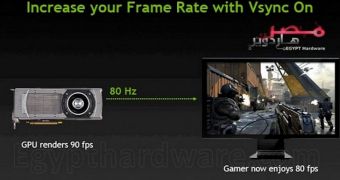Earlier today, we reported on the appearance of the first photos of the NVIDIA GeForce Titan graphics cards, and its full specifications, but there might have been two things we missed.
As the folks at WCCFtech were kind enough to point out, Titan has two very specific assets that its predecessors do not.
One of them is the 80 Hz adaptive Vsync technology, which increases the limit of Vsync from 60 Hz.
Titan can handle 90 FPS, but it is often a good idea to apply Vsync in games because too many FPS can cause screen tearing, while low FPS cause stuttering.
The other thing worth specifically mentioning is the GPU boost 2.0 technology, which dynamically adjusts voltage based on GPU temperature when overclocking it.
Previously, GPU Boost took note of the TDP, but GPU Boos 2.0 will increase voltage when needed and safe.
That is why, despite the spec sheet saying 837 MHz is the base clock and 878 MHz is the Boost clock, it might be possible for the latter to go above even 900 MHz, though there probably won't be a need for any overclocking in the first place.

 14 DAY TRIAL //
14 DAY TRIAL //